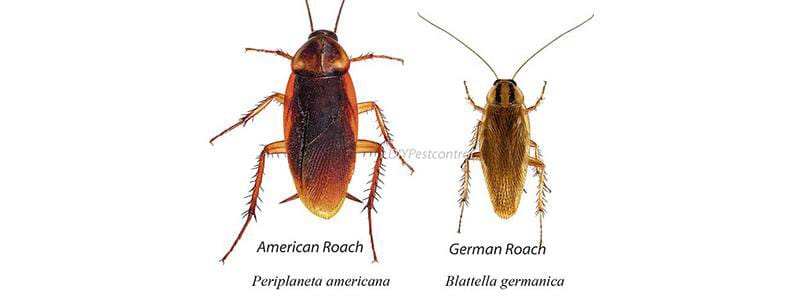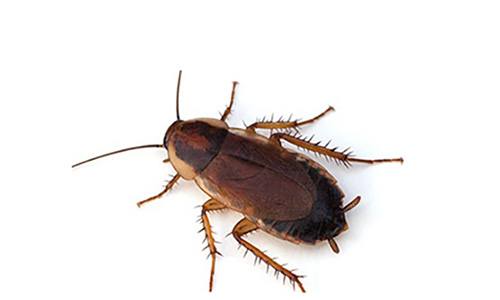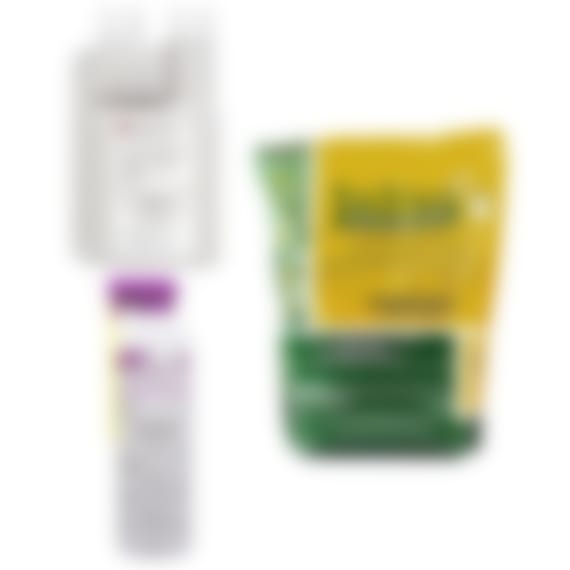
How to Get Rid of Roaches
March 28, 2024
Cockroaches are both unpleasant and unsanitary. Getting rid of roaches can be tricky because the two most common cockroach types (German or American cockroaches) use different roach control treatment plans for elimination.
Below we'll discuss the four key steps in learning how to get rid of roaches and describe the primary roach species you'll likely be dealing with.
4 Key Steps To Get Rid Of Roaches
After determining what kind of cockroach you have, follow the recommended treatment plans. We have tips on inspecting for roaches, critical sanitation/exclusion procedures, and the best treatment options.
1. Roach Identification
The first step in a roach control treatment plan is to identify which type of roach you have. To determine which type of roach you have, first look at their sizes. Afterward, compare physical features and habitats from the information below. You may need a flashlight, glue traps, or glue boards to catch them. Identifying the type of roaches you’re dealing with is the most important step to building an effective eradication strategy! When in doubt about their identification, please contact us.
2. Cockroach Inspection
Proper inspection is critical to success in getting rid of roaches. Are the roaches the smaller type of roach (an inch or less)? Do they scurry over your kitchen counter when you turn on the light? These are typically German Roaches.
Do you have larger cockroaches (about 1.5 inches) that mostly live outside and occasionally come inside? Larger roaches require a different treatment plan.
3. Sanitation
The third step in getting rid of roaches is to investigate sanitation issues and get rid of them. Since cockroaches need food, water, and a harbor location, it is essential to eliminate these sources as much as possible. Roaches eat any food spills, leftover food, and pet food in the kitchen and will search for it around standing water sources.
4. Treatment Plans
Based upon identification and inspection, choose your best treatment plan for the type of roach that is present.
5. Apply Roach Control Products
The best roach-killer products include Aerosols, Insecticides, Dust/Dusters (only a light dusting is needed), Gels, Granulars, Baits, Roach Traps, Insect Growth Regulators (IGRs), and German Roach Kits.
Roach Identification by Adult Size & Habitat
Roaches: American vs. German
The first question that we ask when someone says that they have roaches is, “Where are they living, and how big are they?” Correctly identifying what kind of cockroach you have is vital and a key to successfully treating a roach infestation.
Smaller Roaches
Smaller adult roaches include the German and Brown-Banded roaches. The most invasive of these two types of cockroaches is the German Roach.
The smaller German roach is just 1/2"-1" in the adult stage with a light golden brown color. They have two distinctive bands behind their heads. The other smaller roach, the Brown-Banded roach, has bands along its wings. These smaller roaches live and breed inside, making the treatment plan the same. The German roach is the most common of the smaller roaches and the most difficult to control.
You find these cockroaches in places with water or food, such as kitchens and bathrooms. These roaches commonly live behind and under sinks, stoves, and refrigerators. You may find these cockroaches in floor drains in commercial kitchens.
They live in dark places and are nocturnal. It is common to spot these cockroaches when you enter a kitchen or bathroom and turn on the light. You can see these small, golden-brown roaches scampering on the counters.
Larger Roaches
Large adult roaches include the American roach, Australian, Smoky Brown Oriental Roaches, and the Woods Roach. The most common of the larger-sized roaches is the American roach. The American roach is second only to the German cockroach in abundance.
The American roach is reddish-brown and is about 1.5 " or longer. Also known as water bugs or palmetto bugs, these larger-sized cockroaches are not known to spread disease like the German roach. All roach treatment options are similar for larger cockroaches.
The American roaches are common in warmer climates or during the warmer spring, summer, and fall months. They mainly live outside in organic mulch material but will also be found in basements, woodpiles, attics, hollow trees, under roof shingles, and attics.
They are often found inside after extreme weather conditions, like heavy rain or drought conditions.
Most of the time, they breed outside. However, if conditions are right, they will reproduce inside. For example, you may find an American roach population behind a wall that has had a water leak causing a moist environment.
There are other roaches, but the primary types of cockroaches you'll be dealing with are German, American, and brown-banded roaches.
Health Hazards of German and Brown-Banded Roaches
It is crucial to get rid of German cockroaches and Brown-banded cockroaches as they are health hazards. They carry bacteria that can be transmitted to humans.
The primary diseases are gastroenteritis, including food poisoning, dysentery, and diarrhea. Asthma and allergies may be triggered by the German roaches' feces, body parts, or salvia that are circling in the air.
Health Hazards of American Roaches
Since American roaches move from sewers into homes or commercial establishments, they can be a health concern. They carry bacteria, viruses, and parasites on their bodies, which lead to dysentery, diarrhea, and salmonella.
These health concerns are not of the same magnitude as the German cockroaches since larger cockroaches usually live and breed outside.
Roach Treatment Plans
German Roach Control Treatments
Use primarily roach baits and an insect growth regulator to treat Brown-Banded and German roaches. Treat other roaches, such as the larger American roach, with insecticide concentrates sprayed outside and at entry points to your house. Once they've found entry points, roaches can be relentless.
Using Roach baits and using growth regulators are key to getting rid of these cockroaches. We have both roach baits and IGRs combined in kits for greater savings.
Option 1: German Roach Spray Kit
This kit for German roach control contains all that you need if you prefer to spray for German roach control. It contains a non-repellent insecticide called Advion WDG, an IGR called Tekko Pro, and a contact/flushing aerosol called Stryker 54. Advion WDG kills adult cockroaches with Indoxacarb (for pyrethroid-resistant roaches).
It is advantageous to use a non-repellent insecticide for german roach control instead of a general repellent. The cockroaches will avoid a repellent insecticide. The Tekko Pro is our top-rated IGR with combined chemistry to stop reproduction (Pyriproxyfen) and (Novaluron) which stops the chitin process, decreasing survival chances.
Shockwave Aerosol contains pyrethrin and PBO for a quick knockdown that will kill adult roaches and has flushing capabilities.
Option 2: Ultimate German Roach Bait Kit
The Ultimate German Roach Bait Kit combines high-quality roach gel bait like Invict Gold and roach Insect Growth Regulators to prevent maturity, Invade Bio Zap, and a qt sprayer. It includes Invade Bio Zap, which is a microbial, natural probiotic liquid that eats away organic odors and allergens. It leaves a fresh citrus scent.
Key Takeaway
IGRs are invaluable for getting rid of German Roaches and can be used with poisoned bait or insecticide Sprays.
American Roach Control Treatments
Spraying a residual insecticide and using granular baits are the best options for preventing and removing these larger types of cockroaches. This type of roach is easier to treat than the smaller type of roach like the German roach.
Certain cockroaches gain resistance over time to pesticides. We stay current with the best treatment options available on the market.
You can also place sticky traps such as Victor Pheromone Traps #327RPT on the kitchen counters at night to catch them and take a picture. Send an email with the picture attachment, and we will be glad to help you with identification.
Roach bombs are another popular choice, as they cover a given space with a fine mist. However, this might be impractical in eating areas.
Boric acid can lure and kill roaches on contact. While boric acid is effective, it can be messy.
Eliminate Roaches Naturally
There are several natural remedies available, but they are not known to be as effective. Some people prefer to use a natural remedy consisting of baking soda. Mixing baking soda with sugar will attract cockroaches, and they will eventually die when it's consumed. Others have had some success and claim diatomaceous earth kills cockroaches. Like boric acid and baking soda, diatomaceous earth can be messy to clean up. We generally direct our customers to tried and true baits and insecticides for cockroaches.
Key Takeaway
Exterior perimeter treatments are crucial when treating for American roaches and larger-sized cockroaches. Often, you'll find German roaches inside, while the American cockroach generally spends more time outdoors, so treating these potential entry points is crucial.
How to Prevent Roaches
Sanitation and exclusion techniques are important tools in helping you get rid of roaches and prevent an additional cockroach infestation. Roaches need food, water, and an undisturbed place to shelter. You can prevent cockroaches by disrupting these three components of their life.
As much as possible, eliminate their food and water sources, as well as any shelter, as you begin your roach control treatment plan. Take extra care to reduce any standing water sources.
Many homeowners will sprinkle diatomaceous earth around likely entry points to create a barrier.
German Cockroaches and Brown-Banded Cockroaches
For the German cockroach and the brown-banded cockroach, it is critical to clean your kitchen and bathrooms when you begin a cockroach bait program.
Pay attention to crumbs and grease in the kitchen and unclean tubs, showers, and countertops in the bathrooms. If you do not clean well, getting rid of these types of roaches will be more challenging.
-
Keep clean dishes, kitchen sinks, counters, and bathroom cabinets. Thoroughly empty and clean cabinets.
-
Keep pet food picked up.
-
Thoroughly clean up any food spills.
-
Remove all grease and food particles by cleaning and vacuuming.
-
Do not leave any food out in the open, and seal all food containers. Airtight containers or properly sealed containers are best.
-
Remove indoor trash.
-
Get rid of cardboard boxes, empty soda bottles, and stored paper bags.
-
Clean up any dead roaches to prevent contamination.
American Cockroaches and Larger Roaches
For the larger outdoor types of roaches, it will be helpful to remove or treat any harborage around the home, like mulch and pine straw. Seal cracks and crevices around windows, doors, and plumbing that roaches may use to enter the home. Eliminating food sources and blocking entry points are critical steps to keep roaches out of your home. Roaches consume almost any food source, so this is why it's crucial to store food properly to attain cockroach control.
-
Get rid of trash regularly and keep your kitchen clean.
-
Keep dumpsters clean and use a tight lid on garbage cans.
-
Keep gutters clean and move stored firewood as far as possible away from the house.
-
Keep dishes clean. Dirty dishes quickly attract cockroaches. Get rid of any disposable tableware.
-
Seal cracks and crevices to the outside on the ground level.
-
Inspect window and door frames for gaps and seal them.
-
Inspect the exterior of houses for any signs of a cockroach infestation, such as leaky pipes, leaky faucets, or any appliance that goes into a home; caulk and seal if necessary. If you prefer to naturally prevent cockroaches, creating a barrier near entry points with diatomaceous earth may help.
DIY Pest Control can Help You Get Rid of Roaches
If you've been having a roach problem or roach infestations in the past, you know how frustrating it can be. They're unsettling and unsanitary and killing roaches can be tricky without the right tools at your disposal. We understand how to quickly get rid of roaches through years of experience and know how to guide you to products that will kill cockroaches fast.
There's no need to call an expensive professional exterminator - our pest control experts have everything you need to succeed and kill all the roaches permanently. With DIY Pest Control, a pest control professional can assist you with finding the right product that kills roaches and what you'll need to completely eliminate roaches and prevent roach infestations.
Shop Roach Control ProductsHow To Get Rid of Roaches
Learn how to get rid of roaches yourself following roach control treatment plans.
4 Key Steps To Get Rid Of Roaches
- Roach Identification: The first step for a roach control treatment plan is to identify which type of roach you have. To determine which type of roach you have, first look at their sizes. Afterward, compare physical features and habitats from the information and links below. You may need a flashlight or glue boards to catch them. When in doubt about their identification, please contact us.
- Inspection: Proper inspection is critical to success in a roach control treatment plan. Are the roaches the smaller type of roach (an inch or less)? Do they hurry over your kitchen counter when you turn on the light? These are typically German Roaches. Do you have the larger roach (about 1.5 inches) that mostly lives outside and occasionally comes inside? Larger roaches require a different treatment plan.
- Sanitation: The third step in getting rid of roaches is to investigate sanitation issues. Since roaches need food, water, and a harbor location, it is essential to eliminate these sources as much as possible.
- Get Rid Of Roaches (Treatment Plans) - Based upon identification and inspection, choose your best treatment plan for the type of roach that is a present.
How to tell the difference between the smaller German Roaches or the larger American Roaches
How to tell the difference between the smaller German Roaches and the larger American Roaches
Roach Identification by Adult Size and Habitat
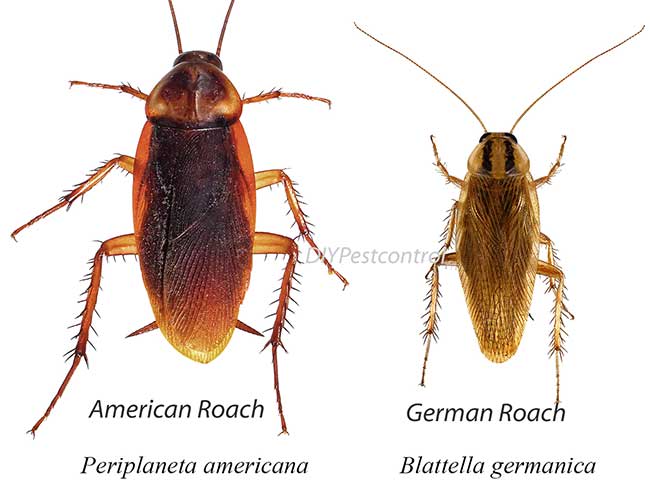
The first question that we ask when someone says that they have roaches is, “Where are they living and how big are they?” Correctly identifying what kind of cockroach you have is vital and a key to successfully treating a roach infestation.
More Identification and Inspection Help
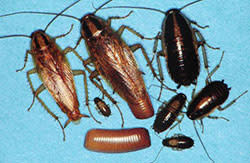
Smaller Roaches
Smaller adult roaches include the German roach and the Brown-Banded roach. The most invasive of these two types of cockroaches is the German Roach
The smaller German roach is just 1/2"-1 " in the adult stage with a light golden brown color. They have two distinctive bands behind their heads. The other smaller roach, the Brown-Banded roach, has bands along with their wings. Both of these smaller roaches live and breed inside, and the treatment plan would be the same. The German roach is the most common of the smaller roaches and the most difficult to control. You find these roaches in places that have water or food, such as kitchens and bathrooms. These roaches commonly live behind and under sinks, stoves, and refrigerators. Find these roaches in floor drains in commercial kitchens. They live in dark places and are nocturnal. It is widespread to spot these roaches when you enter a kitchen or bathroom and turn on the light. You can see these small, golden-brown roaches scampering on the counters.
Are they the smaller type of roach (adults - 1/2 - 1") you see on the kitchen counters when you turn on the light?
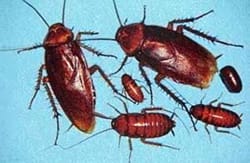
Larger Roaches
Large adult roaches include the American roach, Australian, Smoky Brown Oriental Roaches, and Woods Roaches. The most common of the larger sized roach is the American roach. The American roach is second only to the German cockroach in abundance.
The American roach is reddish-brown and is about 1.5 " or longer. Many people refer to these types of roaches as water bugs or palmetto bugs. These larger sized roaches are not known to spread disease as compared to the German roach. All the treatment options are similar to the larger roaches.
Are they the larger type of roach (adults 1.5 " or more) that you occasionally see in the kitchen or other areas in your home?
German Roach Control Treatments
Identifying the presence of German or Brown-Banded roaches is essential for proper control measures. They breed inside and contaminate their living environments while most larger adult cockroaches do not reproduce inside. The most common larger roaches breed outside, and target treatment areas would be different.
Use primarily roach baits and insect growth regulators to treat German roaches and Brown-Banded roaches. Treat other types of roaches, such as the larger American roach with insecticide concentrates sprayed outside and entry points to your house. Using Roach baits and using growth regulators are keys to getting rid of these roaches. We have both roach baits and insect growth regulators (IGRs) combined in kits for greater savings.
Click Here: German Roach Treatments
Getting Rid of German Roaches with Professional Roach Control Products
This kit for german roach control contains all that you need if you prefer to spray for German roach control. It contains a non-repellent insecticide called Advion WDG, an IGR called Tekko Pro, and a contact/flushing aerosol called Stryker 54. Advion WDG kills the adult roaches with Indoxacarb (for pyrethroid-resistant roaches). It is advantageous to use a non-repellent insecticide for german roach control instead of a general repellent. The roaches will avoid a repellent insecticide. The Tekko Pro is our top-rated IGR with combined chemistry to stop reproduction (Pyriproxyfen) and (Novaluron) that stops the chitin process, decreasing survival chances. The Stryker 54 Aerosol contains pyrethrin and PBO for a quick knockdown and has flushing capabilities.Inspect: Using a flashlight, inspect for roach feces to determine the German roach shelters or harbor areas. If necessary, pull out cabinets and drawers to get a closer look.
Combine Advion WDG and Tekko Pro IGR: Mix 1 packet of Advion WDG and 1 oz of Tekko Pro IGR in a 1/2 gallon of water. Since most German roaches are just in the kitchen and bathrooms, 1/2 gallon of finished solution is plenty to start. Spray cracks and crevices where the roaches are running, behind and under ovens, stoves, refrigerator, between the refrigerator and nearby appliance, behind microwaves, toasters, ovens, coffee makers, dishwashers.
Use Flushing Aerosol: After spraying the combined solution, spray the Stryker 54 aerosol behind and under and behind refrigerators, ovens, stoves, between the refrigerator and nearby appliance, behind microwaves, toasters, ovens, coffee makers, dishwashers, and light switch plates. These are areas where the German roaches are hiding and the Stryker 54 will flush them out and make them run out over the freshly sprayed surface.
Monitor: Allow a few days for the roach population to decline and then put out the Catchmaster Insect Trap and Monitors. You can separate them into three small traps or use them as one larger trap. Remove the release paper to expose the glue and then fold them into a "tent".Place them in areas where roaches have been or are likely to be. Use the adhesive strip on the bottom to attach them to walls or under counters. Monitor the traps frequently to help identify areas of heavy roach activity. As the roach population decreases, the traps are an excellent way to discover and pinpoint new roach activity
Follow Up: Retreat if necessary in one month. For additional treatment, use the optional add on of Invict Roach Bait Gel. Apply Invict Gold in small spots about 1/4" in diameter (size of a pea).
Ultimate German Roach Bait Kit
The Ultimate German Roach Bait Kit combines a high-quality roach gel bait like Invict Gold and Insect Growth Regulators to prevent maturity, Invade Bio Zap, and a qt sprayer. It includes Invade Bio Zap, which is a microbial, natural probiotic liquid that eats away organic odors and allergens. It leaves a fresh citrus scent.
Inspect First and Bait Placements: Place these roach baits in their harborage areas after proper inspection. A flashlight would be helpful in your inspection.
Kitchen: Look for the evidence of German Roaches in such places as kitchen drawers, behind and under appliances, kitchen counter, and oven hood, and microwaves and toasters, cracks and crevice of kitchen cupboards and pantry. Typical areas include, behind kitchen cabinets, countertops, under stoves, around pipes and cracks and crevices.
- Gentrol IGR: Place the Gentrol Point Source device in areas where roach activity has been observed.
- If using Tekko Pro IGR, mix it at the rate of 1 oz per 1/2 gallon of water and spray in their hiding places such as behind and underneath stoves, dishwashers, refrigerators, beneath sinks. For ongoing maintenance, repeat Gentrol Point Sources every six months if you live in an apartment.
Bathrooms: If they are in the bathrooms, apply along the sinks, toilets, in cabinets, and behind any wall hangings.
Living Rooms and Other Rooms: Look under beds or couches where crumbs and other food particles may have accumulated. In laundry, areas check behind and under the washer and dryer.
Key Takeaway
Insect Growth Regulators (IGRs) are invaluable for eliminating German Roaches and can be used with Baits or insecticide Sprays.
Roach Treatment Plans for German and American Roaches
Getting Rid of American Roaches with Professional Roach Control Products
American Roach Control Treatments
Spraying a residual insecticide and using granular baits are the best options for preventing and removing these larger types of roaches. This type of roach is easier to treat than the smaller type of roach like the German roach. Certain roaches gain resistance over time to pesticides. We stay current with the best treatment options available on the market.
Click Here: American Roach Treatments
If you need help identifying the type of cockroach, call us at 1-800-476-3368, and we can explain the treatment options. You can also place sticky traps such as Victor Pheromone Traps #327RPT on the kitchen counters at night to catch them and take a picture. Send email with the picture attachment and we will be glad to help you with identification. Refer to this Roach Treatment Chart or MGK's PDF of Roach Identification for a quick comparison glance.
German Roach and Brown Banded Roach -Habitat and Entry
These roaches do not forage from the outside but travel from one apartment/ suite to the adjoining unit. They are brought inside or hitchhiked in items such as luggage, boxes, and grocery products. German roaches live and breed inside; they can live all season long since they are in a warm, comfortable environment. German roaches are brought in via luggage, furniture, handbags, or boxes from an infested location. During the warmer months, they can move from building to building. In commercial settings, they can move from one connecting unit to the next thru drop ceilings and standard plumbing and electrical elements.
Health hazards of the German roach and Brown-Banded roaches
German cockroaches and Brown-banded cockroaches are health hazards; they carry bacteria that are transmitted to humans. The primary diseases are gastroenteritis, including food poisoning, dysentery, and diarrhea. Asthma and allergies may be triggered by the German roaches' feces, body parts, or salvia that are circling in the air.
American Roach and Larger Roach-Habitat and Entry
The American roaches are common in warmer climates or during the warmer spring, summer, and fall months. They mostly live and breed outside and wander inside for water and food. They are often found inside after extreme weather conditions, like heavy rain or drought conditions. They mainly live outside in organic, mulch material. They will also be found in basements, woodpiles, attics, hollow trees, under roof shingles, and in attics. They are common in steam tunnels in the northern states in the USA. Most of the time, they breed outside. However, if conditions are right, they will reproduce inside. For example, you may find an American roach population behind a wall that has had a water leak causing a moist environment.
Health hazards of American roaches
Since American roaches move from sewers into homes or commercial establishments, they can be a health concern. They carry bacteria, viruses, and parasites on their bodies, which lead to dysentery, diarrhea, and salmonella. These health concerns are not at the same magnitude of the health concern from German roaches since most of the time, they live and breed outside.
Key Takeaway
Exterior perimeter treatments are crucial when treating for American roaches and larger sized roaches.
How to Prevent Roaches and Sanitation

Preventing Roaches
Sanitation and exclusion techniques are important tools in your roach control program. Roaches need food, water, and an undisturbed place to shelter. As much as possible, eliminate their food, water, and shelter as you begin your roach control treatment plan.
German and Brown-Banded Roaches
For the German roaches, it is critical to clean your kitchen and bathrooms while beginning a roach baiting program. Pay attention to crumbs and grease in the kitchen and unclean tubs, showers, bathroom countertops in the bathrooms. If you do not clean well, getting rid of these types of roaches will be more challenging.
- Keep clean dishes, kitchen sinks, counters, and cabinets.
- Keep pet food picked up.
- Remove all grease and food particles by cleaning and vacumming.
- Do not leave any food out in the open and seal all food containers.
- Remove indoor trash.
- Get rid of cardboard boxes, empty soda bottles, and stored paper bags.
- See more tips at: German Roaches
American and Larger Roaches
For the larger outdoor types of roaches, it will be helpful to remove or treat any harborage around the home like mulch and pine straw. Seal cracks and crevices around windows, doors, and plumbing that roaches may use to enter the home.. Eliminating food sources and blocking entry points are critical steps to keep roaches out of your home.
- Remove trash regularly and kitchen clean.
- Keep dumpsters clean and use a tight lid on garbage cans.
- Keep gutters clean and move stored firewood as far as possible away from the house.
- Keep dishes clean.
- Seal cracks and crevices to the outside on the ground level.
- Inspect window and door frames for gaps and seal.
- Inspect the exterior of houses such as pipes or any appliance that goes into a home; caulk and seal if necessary.
- See more tips at: American Roaches.
Written by our resident pest control expert Ken Martin.




